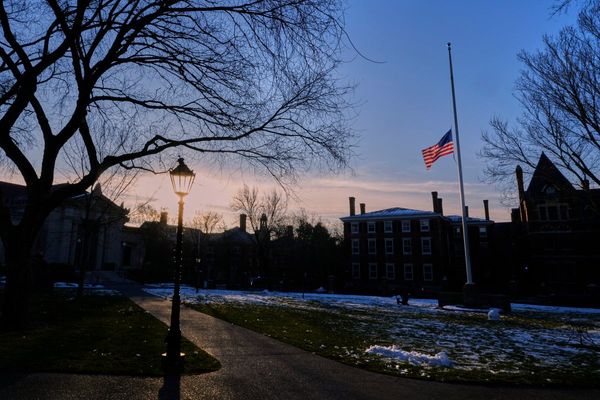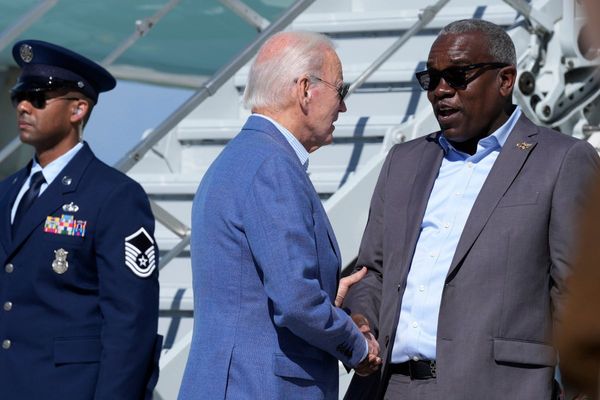
The federal government is in the final throes of a lobbying campaign to secure UN world heritage status for a globally significant rock art site in Western Australia.
The federal environment minister, Murray Watt, will be in Paris this week to convince the 21-country world heritage committee to ignore concerns about industrial emissions at Murujuga, and instead place the site on the world heritage list.
What is the Murujuga rock art complex?
There are between 1m and 2m pieces of rock art across the Murujuga cultural landscape in Western Australia’s Pilbara region. Some are 50,000 years old.
Many of the pieces – known as petroglyphs – have been created using a method known as “pecking” where a harder rock is hit against another rock to reveal a different colour. They depict plants, animals – some of which are now extinct – and humans.
The International Council on Monuments and Sites (ICOMOS) advises Unesco and the world heritage committee, and has described Murujuga as “an exceptional example of human artistic achievement” and an “extraordinary cultural landscape of global significance”.
The site, covering almost 100,000 hectares, was initially the land of Yaburara people who were massacred by colonists in 1868. The Ngarda-Ngarli people now look after the site.
What makes Murujuga eligible to be a world heritage site?
Places that appear on the world heritage list – such as the Great Barrier Reef, the Sydney Opera House and the Blue Mountains – are judged to be of “outstanding universal value to humanity” if they meet at least one of 10 criteria.
Murujuga is being nominated for three criteria: the site represents “a masterpiece of human creative genius”; is a unique testimony to a cultural tradition; and is an outstanding example of a cultural or human settlement showing interaction with the environment.
ICOMOS has agreed the site meets all three criteria.
Why did Unesco’s advisers recommend Murujuga’s nomination be blocked?
Unesco advisers recommended in May that the world heritage nomination be blocked and referred back to Australia until nearby “degrading acidic emissions” were stopped.
Murujuga is close to several industrial sites, including a fertiliser plant and Woodside’s Karratha gas plant. Watt has provisionally approved an extension until 2070 for Woodside’s North West Shelf project, which includes the gas plant.
ICOMOS has said the site is “extremely vulnerable to industrial pollution” and said the nomination should be referred back to Australia so the country could “ensure the total removal of degrading acidic emissions, currently impacting upon the petroglyphs” and “prevent any further industrial development adjacent to, and within, the Murujuga Cultural Landscape”.
The government and the Murujuga Aboriginal Corporation (MAC), which has led the nomination, claim ICOMOS has relied on “factual inaccuracies” and say a major monitoring project carried out by 50 scientists shows there are no ongoing risks to the rock art.
Some conservationists, including the traditional owner-led Save Our Songlines, as well as a small independent group of rock art experts, claim emissions are damaging the rock art.
How will the Australian government try and overturn the recommendation?
The government has been lobbying Unesco and world heritage committee countries for more than a month.
Watt has told Guardian Australia the government needs to persuade at least one of the 21 committee member countries to move an amendment at the 10-day meeting to immediately inscribe the site on the world heritage list. He has also argued a successful nomination would increase the protection of the rock art.
If an amendment is moved, this will give MAC and the government a chance to argue their case, and for an amendment to be accepted, negotiated or rejected. Votes are rare, with most decisions made by consensus.
The Murujuga site was provisionally scheduled to be discussed very late on Friday or early on Saturday, Australia time.
Who is going to the meeting?
There are four delegations from Australia in Paris this week, and three are attempting to persuade the 21-country committee to ignore the ICOMOS recommendation.
Watt will lead a government delegation of about a dozen staff, alongside a small WA government delegation led by the state’s environment minister, Matthew Swinbourn, and a delegation of 11 from MAC.
A delegation from campaign group Save our Songlines, led by a Mardathoonera woman and Murujuga traditional custodian, Raelene Cooper, a former chair of MAC, is also in Paris and wants a “provisional decision” to list Murujuga, subject to the full implementation of the ICOMOS recommendations.
Cooper claims the government wants to “have their cake and eat it” by approving the Woodside plant while claiming it won’t damage the rock art.
What is the world heritage committee?
Unesco coordinates the world heritage committee process and accepts guidance from advisers, such as ICOMOS.
But the committee itself is sovereign and is made up of 21 countries, with each having a six-year term.
There has been growing criticism that the committee is becoming increasingly politicised, with UN advice being too often ignored.
The current lineup is Argentina, Belgium, Bulgaria, Greece, India, Italy, Jamaica, Japan, Kazakhstan, Kenya, Lebanon, Mexico, Qatar, South Korea, Rwanda, Saint Vincent and the Grenadines, Senegal, Turkey, Ukraine, Vietnam and Zambia.







